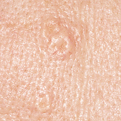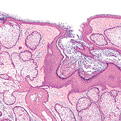Sebaceous Hyperplasia
General Information
Sebaceous Hyperplasia is a benign condition involving an enlargement of the oil glands on the skin. The lesions are mainly seen in locations where many oil glands are found including the nose, cheeks and forehead. Sebaceous hyperplasia appears as slightly white, flesh or yellow colored papules up to 3 mm in diameter. Researchers believe that sebaceous hyperplasia is caused by a decrease in the circulating levels of androgen associated with aging. Sebaceous hyperplasia has also been linked to individuals on the medication cyclosporin A and in post-transplantation patients. Treatment is not necessary, as the condition is benign; however, lesions can be removed by light cautery, diathermy or laser vaporization.
Epidemiology
1% of the healthy population, 10-16% in patients receiving long-term immunosuppression with cyclosporin A in the United States.
Etiology
Unknown; Linked to a decrease in the circulating levels of androgen associated with aging
Pathogenesis
Decrease in cellular turnover results in crowding of primitive sebocytes within the sebaceous gland, causing a benign hamartomatous enlargement of the sebaceous gland, or sebaceous hyperplasia
Clinical
Whitish-yellow or skin-colored papules that are soft and vary in size
Histology
Mature sebaceous lobules have one or more basal cell layers at their periphery, with undifferentiated sebocytes that contain large nuclei and scant cytoplasmic lipid.
Bibliography
1. “Sebaceous Hyperplasia” (Online). February 2007. http://www.emedicine.com/derm/topic395.htm (visited: April 3, 2008) 2. “Sebaceous Hyperplasia” (Online). http://www.health-disease.org/skin-disorders/sebaceous-hyperplasia.htm (visited: April 3, 2008)
Download PDF
![]() Sebaceous Hyperplasia
Sebaceous Hyperplasia


